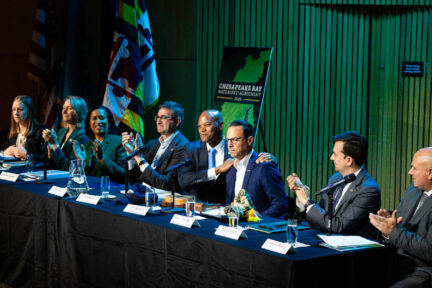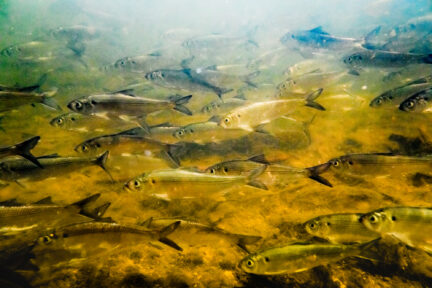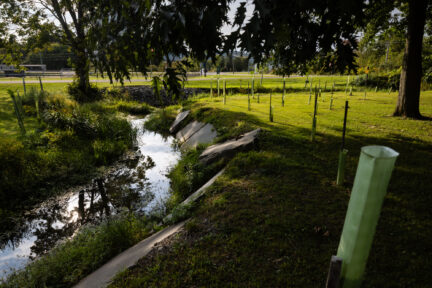Underwater grasses in the Chesapeake Bay continue record growth for third year in a row
Underwater grasses in the Chesapeake Bay continue record growth for third year in a row
In 2017, an estimated 104,843 acres of underwater grasses were mapped in the Chesapeake Bay: the highest amount ever recorded by the Virginia Institute of Marine Science (VIMS) and the first time in our decades-long history of monitoring this critical habitat that the total abundance surpassed 100,000 acres. This marks the third consecutive year in which the acreage of underwater grasses reported for the Bay was the highest ever recorded since annual surveying began in 1984.
This total is 14,843 acres greater than the Chesapeake Bay Program's 2017 restoration target and 57 percent of the ultimate restoration goal adopted in the Chesapeake Bay Watershed Agreement. Notably, a five percent increase in underwater grass abundance was observed just from 2016 to 2017.
Experts attribute this rise in underwater grass abundance to a strong increase in the very salty, moderately salty and tidal fresh regions of the Bay. The very salty regions of the Bay saw a sustained recovery of eelgrass, while the moderately salty regions of the Bay saw a continued increase in widgeon grass. Because widgeon grass is a "boom and bust" species whose abundance can rise and fall from year to year, a widgeon-dominant spike is not guaranteed to persist in future seasons. The wild celery, water stargrass and other species that have returned and reached new parts of the tidal fresh region of the Bay are less susceptible to rapid fluctuations in abundance.
Because underwater grasses are sensitive to pollution but quick to respond to water quality improvements, their abundance is a good indicator of Bay health. In a research article published by the Proceedings of the National Academy of the Sciences in March 2018, scientists link the resurgence of underwater grasses to the nutrient reductions made under the Environmental Protection Agency's Chesapeake Bay Total Maximum Daily Load, indicating that this "pollution diet" and local conservation incentives have resulted in a healthier Chesapeake Bay.
Underwater grass abundance can vary from species to species and river to river. In 2017, local highlights included:
- Northeast Maryland: Underwater grass abundance in the Gunpowder River increased 34 percent between 2016 and 2017, from 912 acres to 1,219 acres. Underwater grass abundance in the neighboring Bush River increased 103 percent, from 62 to 126 acres.
- Central Maryland: Underwater grass abundance in the Patapsco River increased 313 percent between 2016 and 2017, from 3 to 14 acres.
- Southern Maryland: Underwater grass abundance in the Lower Patuxent River increased 301 percent between 2016 and 2017, from 32 to 130 acres.
- The District of Columbia: Underwater grass abundance in the Anacostia River increased 58 percent between 2016 and 2017, from 8 acres to 13 acres.
- Southeast Virginia: Underwater grass abundance in the Upper James River increased 389 percent between 2016 and 2017, from 92 acres to 448 acres. Grass abundance in the Middle James River increased 37 percent, from 52 to 71 acres.
Facts
Between 2016 and 2017, underwater grass abundance in the regions of the Chesapeake Bay that were mapped in both years increased five percent from 97,638 acres to 102,788 acres. The 2017 total of 104,834 acres surpasses the Chesapeake Bay Program’s 2017 restoration target and marks a 57 percent achievement of the partnership's ultimate restoration goal.
In 2017, two Maryland and two Virginia rivers surpassed their underwater grass restoration goals: the Northeast River and Fishing Bay in Maryland, and the Rappahannock and Chickahominy rivers in Virginia. Additionally, seven Maryland rivers, four Virginia rivers and two District of Columbia rivers had segments that surpassed their restoration goals: the upper portion of the Big Annemessex, the upper Chester, the lower Elk, the upper Gunpowder, the upper Manokin, the mouth of the Choptank and Chesapeake & Delaware Canal in Maryland; the middle portion of the James, the upper Pamunkey, the upper Potomac and the upper Mattaponi in Virginia; and the Anacostia and upper Potomac River in Washington, D.C.
Tracking Bay Grass Abundance by Salinity Zone:
Between 2016 and 2017:
- Bay grass abundance in the Bay's fresh waters (the Tidal Fresh Salinity Zone) rose 2,462 acres (from 17,418 acres to 19,880 acres), achieving 96.5 percent of the zone goal. Note: researchers were not able to collect aerial imagery over a portion of this zone in 2016. A comparison between the regions of the zone that were mapped in both 2016 and 2017 shows underwater grass abundance rose 1,155 acres.
- Bay grass abundance in the Bay's slightly salty waters (the Oligohaline Salinity Zone) fell 190 acres (from 8,588 acres to 8,398 acres), achieving 81.3 percent of the zone goal.
- Bay grass abundance in the Bay's moderately salty waters (the Mesohaline Salinity Zone) rose 4,140 acres (from 57,191 acres to 61,331 acres), achieving 51.0 percent of the zone goal. Note: researchers were not able to collect aerial imagery over a portion of this zone in 2016. A comparison between the regions of the zone that were mapped in both 2016 and 2017 shows underwater grass abundance rose 3,423 acres.
- Bay grass abundance in the Bay's very salty waters (the Polyhaline Salinity Zone) rose 763 acres (from 14,471 acres to 15,234 acres), achieving 45.3 percent of the zone goal.
Issues
Like grasses on land, underwater grasses need sunlight to survive. When the waters of the Chesapeake Bay become clouded with algae blooms or suspended sediment, sunlight cannot reach the bottom habitat where these grasses grow. While healthy grass beds can trap and absorb some nutrient and sediment pollution—thus improving water clarity where they grow—too much pollution can cause grass beds to die off. Rising water temperatures, strong storms and drought can also affect the growth and survival of underwater plants.
Underwater grass beds also face direct physical threats from human activities. Unaware boaters can pull underwater grasses up from the bottom of rivers, streams and the Bay, leaving propeller scars along the beds. Misunderstandings about the important role that underwater grasses play in the Bay ecosystem can also cause residents to remove grasses, thinking them invasive or otherwise damaging.
Chesapeake Bay Program partners are working to improve water clarity, protect and restore grass beds, enhance bay grass research and expand education and outreach to restore underwater grasses and boost their habitat benefits in the watershed. Read our fact sheet on underwater grasses to learn more about what individuals can do to support their restoration.
Importance
Underwater grass beds are critical to the Chesapeake Bay ecosystem. They keep our waters clean by absorbing excess nutrients, trapping suspended sediment and slowing wave action and shoreline erosion. Underwater grasses also offer food to small invertebrates and migratory waterfowl and shelter young fish and blue crabs. In 2016, the value of the carbon sequestration, nitrogen removal and wildlife habitat provided by the grasses growing in the Chesapeake reached an estimated $220 million.
Because underwater grasses are sensitive to pollution but quick to respond to water quality improvements, their abundance is a good indicator of Bay health. Watershed residents can learn to identify underwater grasses and contribute information to the Bay-wide census of submerged aquatic vegetation by joining the Chesapeake Bay SAV Watchers group and recording their grass sightings in the Water Reporter app. In this way, citizens can help scientists gain a richer understanding of the health of the Chesapeake Bay.
Quotes
"Seeing record growth in underwater grasses for the past three years just reinforces that our efforts to restore the Chesapeake Bay and its local tributaries is working. This achievement is a true example of the power a partnership can have and I call upon all of our partners to continue their efforts toward this remarkable recovery."
--Jim Edward, Acting Director, Chesapeake Bay Program
"It’s exciting to have finally surpassed 100,000 acres of SAV in the Bay. While we're only a bit over halfway to our ultimate restoration goal, this is a big milestone for the Bay Program and its partners. These latest SAV numbers show that all the hard work has been worth it. SAV is so much more than the plants themselves. They mean clear water and shoreline protection, carbon sequestration and climate mitigation. They mean more fish and crabs and waterfowl. And they mean memorable vacations and a healthy environment."
--Brooke Landry, Natural Resources Biologist, Maryland Department of Natural Resources and Chair, Chesapeake Bay Program's Submerged Aquatic Vegetation Workgroup
"2017 was quite an exciting year for the survey. First, we exceeded 100,000 acres for the first time ever in the survey, and now have three successive years of record high numbers. Second, we noted SAV in two areas of the Bay that had not seen any SAV since 1972 (in front of the University of Maryland Center for Environmental Science Laboratory in Solomons Island, Maryland and in the upper York River near Mumfort Island, Virginia. Hopefully this trend will continue in 2018."
--Bob Orth, Director of SAV Aerial Survey, Virginia Institute of Marine Science
"Since, 2009, the District has seen a 96% increase in SAV in the Potomac, making this a real success story for the Chesapeake Bay Program partnership. SAV provides critical habitat for native birds, mussels, and our state fish, the American Shad. It is important for our federal, state, and local partners to keep the momentum as we continue to restore our rivers and the Chesapeake Bay."
--Tommy Wells, Director, District Department of Energy and the Environment



